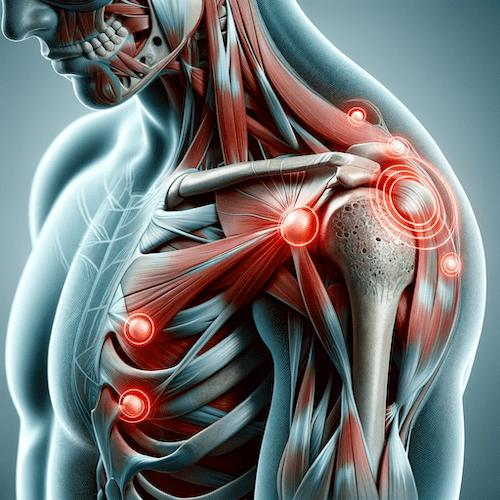Deltoid Trigger Points: Causes, Symptoms, And Treatment Options
If you’ve felt a nagging pain in your shoulder that just won’t go away, you might be dealing with a deltoid trigger point. These pesky knots can cause discomfort and make simple tasks like lifting your arm feel like an uphill battle.
Whether you’re an athlete or someone who spends hours at a desk, deltoid muscle pain is more common than you’d think.
Did you know the deltoid muscle is involved every time you move your arm? When it’s not working right because of trigger points, it can disrupt your whole day. In this article, we’ll guide you through understanding these trigger points, spotting the symptoms they cause, and exploring effective treatments to get your shoulder back on track and avoid the potential of chronic pain.
Get ready for trigger point pain relief – let’s dive into solutions for soothing those stubborn spots!

Key Takeaways
- Deltoid trigger points can cause pain, tenderness, and limited movement in the shoulder area; they are often confused with conditions like bursitis or rotator cuff issues.
- Common causes of deltoid trigger points include repetitive motions, poor posture, injury or trauma, stress and tension, overuse during exercise, imbalanced muscle use, weakness in surrounding muscles, age-related wear and tear, inadequate warm-up before activity and lack of mobility.
- Symptoms may include sharp or aching pains that radiate down to the elbow and difficulties performing daily tasks due to reduced range of motion in the shoulder.
- Treatment options range from self – myofascial release techniques using foam rollers or massage balls to professional therapies such as dry needling and massage. Stretching exercises also offer relief by improving flexibility.
- Preventative measures for avoiding the development of deltoid trigger points include maintaining good posture, warming up properly before activities that strain the shoulders, taking regular breaks from repetitive movements, using ergonomic equipment when sitting for long periods of time-strengthening shoulder muscles gradually increasing workout intensity staying hydrated managing stress effectively.
Understanding Deltoid Trigger Points

Diving into the intricacies of deltoid trigger points reveals a complex interplay between muscle tension and discomfort that can impede daily life. Recognizing the signs and sources behind these sensitive spots is pivotal for effective management and treatment.
Location and Identification
Identifying deltoid trigger points begins by pinpointing the exact areas of tenderness and pain in your shoulder muscles. The deltoid muscle, a large triangular-shaped muscle that covers the shoulder joint, consists of three separate parts: anterior, lateral, and posterior deltoids.
Trigger points in the deltoid are located mainly in these regions. To locate an anterior deltoid trigger point, search for sensitive spots along the front edge of your shoulder. If you’re looking toward the outside or back of your shoulder, you may be dealing with lateral or posterior deltoid trigger points.
As you press on different sections of your deltoid muscle, notice any sharp pains or aches that mimic common symptoms like neck pain or upper arm discomfort—these could indicate active myofascial trigger points.
It’s essential to differentiate between referred pain from other sources such as bursitis or rotator cuff issues and direct pain caused by tight muscle fibers within the deltoids themselves.
Movement tests can also help identify problematic areas; increased pain upon contracting the affected shoulder or lifting your arm beyond 90 degrees often signals a trigger point’s presence.
Consulting with a healthcare professional experienced in myofascial pain is advisable for accurate diagnosis and to determine if what seems like chronic shoulder pain stems indeed from these localized constrictions within your muscles.
Common Causes and Contributing Factors
Once you’ve located the deltoid trigger points, it’s important to understand what might have caused them. This knowledge can help you address the underlying issues and find effective pain relief. Here are some common causes and contributing factors:
- Repetitive motions: Frequent and repetitive activities that involve the shoulder, such as throwing or lifting overhead, can overwork the deltoid and rotator cuff muscles, leading to trigger points.
- Poor posture: Slouching or consistently holding your shoulders in an awkward position can strain the deltoids, especially if you sit at a desk for long hours without proper ergonomic support.
- Injury or trauma: A direct blow to the shoulder, a fall on an outstretched arm, or a dislocation can damage the soft tissue and activate trigger points in the deltoid muscle.
- Stress and tension: Chronic stress often results in tense muscles across the entire body, including the shoulder girdle; this tension may further exacerbate existing trigger points.
- Overuse during exercise: Exercising without adequate rest or not using proper form can overstress the shoulder muscles and increase pain on contraction of these areas.
- Imbalanced muscle use: Relying too much on certain muscles while neglecting others may lead to imbalances in the shoulder area, causing compensatory patterns that strain deltoids.
- Weakness in surrounding muscles: If stabilizing muscles like infraspinatus or supraspinatus are weak, more pressure is put on deltoids during movements like flexion and extension of the arm.
- Age-related wear and tear: As you grow older, muscles naturally lose elasticity and are more prone to injury which includes developing active trigger points within them.
- Inadequate warm-up before activity: Jumping into strenuous activities without properly warming up can shock your muscles into a state where they’re more susceptible to developing trigger points.
- Lack of mobility: Restricted movement in other parts of your body such as back or neck might force your deltoids to overcompensate during arm movements leading to localized discomfort.
Symptoms Associated with Deltoid Trigger Points

When deltoid trigger points take hold, they can manifest through a variety of symptoms that may not only cause discomfort but also interfere with your daily routine. You might experience sharp or aching pains in the shoulder and upper arm regions, reflecting the complex ways these knots affect the surrounding tissues and nerve pathways.
Referred Pain Patterns
Referred pain patterns can be complex and surprising due to the way our nervous system is wired. If you have deltoid trigger points, you might feel discomfort in areas that seem unrelated to your shoulder.
For instance, pain could radiate down your arm or even as far as your elbow. This type of pain often gets mistaken for other conditions like bursitis or a problem with the pectoralis major because it doesn’t always stay put where the trigger point is located.
Recognizing these patterns plays a crucial role in effective treatment. You may notice increased pain on contraction of the deltoid muscle, especially when trying to lift your arm or extend your shoulder.
The referred pain isn’t limited; it can affect both the anterior and posterior parts of your shoulder and upper arm area. Knowing this helps target therapy more accurately, ensuring that relief isn’t just temporary but part of a lasting solution for easing the discomfort associated with these perplexing yet common musculoskeletal issues.
Impact on Mobility and Daily Activities
Moving beyond the discomfort, deltoid trigger points significantly restrict your ability to perform everyday tasks and enjoy activities that require upper body movement. Simple actions like reaching for a high shelf or brushing your hair can become challenging and painful.
The restriction in mobility often stems from an inability to fully raise the arm or rotate the shoulder joint, which is essential for countless daily functions.
Trigger points in the deltoid muscle can lead to stiffness and reduced range of motion, making it hard to move freely without discomfort. This limitation not only affects physical activity but can also disrupt sleep if lying on the affected side causes pain.
Engaging in sports, carrying groceries, or even driving might worsen symptoms as these activities demand fluid shoulder movement that’s often compromised with active trigger points.
Treatment Options for Deltoid Trigger Points
When managing deltoid trigger points, a multifaceted approach is often most effective. Exploring both self-care techniques and professional interventions can significantly reduce pain and improve shoulder function.
Self-Myofascial Release Techniques
Self-myofascial release is a technique you can use to relieve muscle tension and improve flexibility. It acts as a form of trigger point therapy by targeting areas of tightness in the deltoid muscle.
- Begin with a foam roller or a firm massage ball. Position it under the most sensitive area of your shoulder and gradually apply pressure.
- Move slowly over the ball or roller, letting your body weight do the work. If you find a particularly tender spot, hold there for 30 to 60 seconds.
- Breathe deeply during this process to help relax the shoulder muscles. Deep breaths encourage oxygen flow to the sore spots, enhancing recovery.
- Make sure not to roll directly on bones or joints; keep the focus on the soft tissue where trigger points are located.
- Incorporate different angles by adjusting your arm’s position. This reaches all three separate muscles making up the deltoid group.
- Use self-myofascial release before and after exercises to maintain mobility in your shoulder joint. It helps prepare your muscles for activity and aids in recovery post-workout.
- Consistency is key; regularly practice these techniques for best results. Aim to incorporate it into your routine two to three times per week.
Professional Therapies: Dry Needling and Massage
Dry needling is a therapy used by skilled professionals to ease the pain and dysfunction associated with trigger points in the deltoid muscle. During this treatment, thin needles are carefully inserted into specific parts of the muscle, offering relief from shoulder pain as well as improving movement of the shoulder joint.
Patients often experience an immediate reduction in discomfort and an increase in range of motion.
Massage therapy complements dry needling by targeting the soft tissues around the deltoid and supraspinatus muscles. A massage therapist applies various techniques to relax tight muscles, improve blood flow, and facilitate recovery from elbow pain or any discomfort related to arm and shoulder movements.
Together, these professional therapies can significantly relieve pain and help restore full function.
Next on our list is ‘Stretches and Exercises for Relief’, where we will explore how certain movements can further alleviate symptoms of deltoid trigger points.
Stretches and Exercises for Relief
Moving from professional therapies, incorporating stretches and exercises into your routine can provide significant relief from deltoid trigger points. These movements aim to improve flexibility and strengthen the shoulder muscles to prevent future discomfort.
- Pendulum stretch: Lean over slightly, letting your affected arm hang down. Swing the arm gently in small circles, gradually widening the circles over a minute or two—this aids in reducing tension within the deltoid muscle.
- Cross-body reach: Stand or sit comfortably, then bring your affected arm across your body. Use the opposite hand to hold your elbow and gently pull it further across until you feel a stretch in the back of your shoulder.
- Doorway stretch: Position yourself in an open doorway. With elbows bent at 90 degrees, place palms on either side of the door frame at shoulder height. Step forward with one foot while leaning into the doorway until you feel a stretch at the front of your shoulders.
- Shoulder blade squeeze: Sit or stand with arms at your sides. Squeeze your shoulder blades together as if trying to hold a pencil between them; hold for five seconds before releasing. Repeat this movement several times to help strengthen postural muscles and reduce strain on the deltoids.
- Arm raises: Sitting or standing with arms by your side, lift them forward and upward slowly until they are at shoulder level. Lower them back down steadily. This exercise increases range of motion and builds strength in parts of the muscle prone to developing trigger points.
- Wall push-ups: Face a wall, placing hands flat against it slightly wider than shoulder-width apart. Slowly bend your elbows, bringing your chest closer to the wall before pushing back out—ideal for strengthening without excessive strain on the deltoids.
Preventative Measures and Maintenance
Ensuring the long-term health of your deltoid muscles requires consistent attention to both body mechanics and strength. Embrace a proactive stance by integrating specific strategies into your routine that safeguard against the development of trigger points, keeping your shoulders supple and ready for action.
Best Practices for Avoiding Trigger Point Development
Developing trigger points in your deltoid muscle can lead to discomfort and affect your shoulder function. It’s important to take steps to prevent these painful spots from forming.
- Maintain good posture: Slouching or hunching over for prolonged periods puts undue stress on the shoulder muscles, increasing the likelihood of trigger point development.
- Warm-up before activity: Engaging in dynamic stretches and light exercises prepares your deltoid muscles for more intense physical activity and reduces injury risk.
- Take regular breaks: If you have a job or hobby that involves repetitive shoulder use, taking breaks every hour helps relieve muscle tension.
- Use ergonomic equipment: Chairs with proper back support and adjustable armrests, along with appropriately positioned desks, can decrease strain on the shoulders during work.
- Strengthen shoulder muscles: Incorporating exercises targeting the deltoids and surrounding muscles improves overall stability and resilience against trigger points.
- Gradually increase workout intensity: Avoid sudden jumps in exercise weights or repetitions; instead, progressively challenge your muscles to adapt safely.
- Stay hydrated: Proper hydration is vital for maintaining healthy muscle tissue and facilitating recovery after exertion.
- Manage stress effectively: High-stress levels can cause muscle tightening; activities like yoga, meditation, or deep breathing exercises help keep stress in check.
Conclusion
You now understand the basics of deltoid trigger points—from their causes to symptoms, and most importantly, the variety of treatments available. Whether you’re considering self-care strategies or seeking professional help, remember that consistent action is key to relief.
Embrace preventative practices to ensure your shoulders remain strong and flexible. Your path to a pain-free life starts with applying this knowledge and taking control of your shoulder health today.
Sam Visnic
Most Popular Posts
Categories
- Deep Gluteal Pain Syndrome (8)
- Deltoids (2)
- Foam Rolling (2)
- Glutes (9)
- Hamstrings (5)
- Hypnosis for Pain (3)
- Lats (2)
- Levator Scapulae (4)
- Lifestyle (8)
- Massage Therapy (39)
- Mobility (21)
- Movement and Exercise (19)
- Muscles (22)
- Nutrition (2)
- Obliques (1)
- Pain (25)
- Pectorals (3)
- Piriformis (3)
- Plantar Fasciitis (11)
- Psoas (11)
- Quadratus Lumborum (3)
- Quadriceps (2)
- Rhomboids (3)
- Sciatica (1)
- Serratus Anterior (1)
- SI Joint (14)
- Sternocleidomastoid (1)
- Stretching (18)
- Subscapularis (1)
- TMJ (2)
- Trapezius (1)
- Uncategorized (12)









